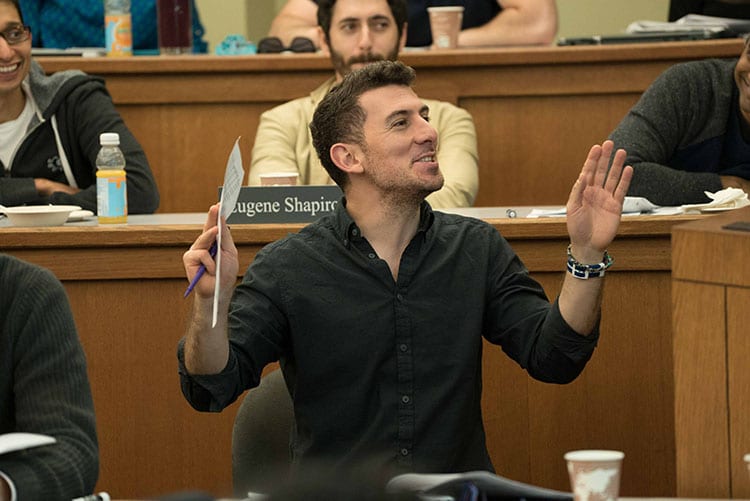Topic: Accounting
Disclosure rules led to drop in bond trading markups

The average transaction fee paid by retail investors to buy or sell corporate bonds fell 5% after regulators forced brokers to disclose these fees, according to new research co-authored by Berkeley Haas Asst. Prof. Omri Even-Tov.
The fee disclosure, which brokerage firms fought for about two decades, finally took effect for some corporate and municipal bond trades in 2018. This paper is the first academic research to examine its impact on trading costs for corporate bonds, and the findings highlight the need for regulators to provide better disclosures to retail investors, Even-Tov said.
“If their fees were fair before this, we shouldn’t have seen any effect, but we do find a reduction,” he said. “They were charging higher fees than they should have been.”
If their fees were fair before this, we shouldn’t have seen any effect, but we do find a reduction…They were charging higher fees than they should have been. —Asst. Prof. Omri Even-Tov
Hidden markups
When companies sell bonds to investors, they are borrowing money. After they have been issued, these bonds are bought and sold “over the counter,” between broker-dealers who trade them with their clients. When a broker charges a client more than the prevailing market price, it’s known as a markup. The difference represents the broker’s profit and the client’s trading cost—akin to a commission.
Until recently, investors had no easy way to know how much they were paying their brokers because the markup was not disclosed; it was embedded in the bond’s price. For example, an investor might have seen that they paid $102.50 for the bond, but not that the firm had purchased it for only $100.
Knowledgeable investors could estimate the markup by looking up the bond’s trading history in a database known as Trace—short for Transaction Reporting and Compliance Engine. They could then negotiate with their broker for a lower markup.
“However, estimating markups imposes information processing costs on investors, potentially creating information asymmetry between unsophisticated investors and bond-market professionals,” wrote the authors, who include Christine Cuny of New York University’s Stern School of Business and Edward Watts from the Yale School of Management.
New disclosure rule
In 2016, the Financial Industry Regulatory Authority, Wall Street’s self-regulator, adopted a rule that required broker-dealers to disclose their markups when they buy corporate bonds and sell them to retail (non-institutional) investors the same day. Brokerage firms take little risk of losing money on same-day trades. The disclosure applied to such trades starting in May 2018.
These markups appear in the confirmation investors receive after they’ve made the trade. That’s too late to negotiate a lower commission, but it could lead customers who previously didn’t know how big these markups are “to reevaluate their brokerage relationship.” Even-Tov and his co-authors wanted to know whether this had led brokers to reduce markups on trades subject to the disclosure.
To test this hypothesis, they used Trace to examine retail-size trades—which they defined as trades of $100,000 or less—during the six months before and six months after the rule took effect. They calculated the markup as the total cost that investors would incur to buy and sell a bond.
On average, they found the markup on same-day retail trades declined by about 5% compared to trades not subject to the disclosure, or from about $431 to $409 on a $50,000 trade, Even-Tov said.
The reduction was larger than average for the smallest trades. “These trades are likely executed by unsophisticated investors who have a limited supply of information processing capacity,” the authors wrote. They also found that the reduction in markups was more pronounced for less-liquid bonds, such as high-yield, long-duration and smaller issues.
Lower costs for consumers
Consumer groups had argued that this long-overdue rule change would give retail investors more information to make better decisions and foster increased price competition. The securities industry had contended that the implementation costs would be significant and passed on to investors. The authors said the 5% savings they observed was after any costs passed to customers.
Markups are large “because frictions in the over-the-counter bond market enable market professionals to take advantage of uninformed investors,” the authors wrote.
“Our findings show that disclosure requirements function as a regulatory tool, and constrain financial professionals’ opportunistic behavior,” Even-Tov said.
The paper, entitled “From implicit to explicit: The impact of disclosure requirements on hidden transaction costs,” is forthcoming in the March edition of the Journal of Accounting Research. Read it online here.
Study finds that some credit analysts leak information to Wall Street to advance their careers

A new study has found compelling evidence that some credit rating analysts leak information about upcoming rating changes to Wall Street to advance their careers.
The paper, co-written by Omri Even-Tov of Berkeley Haas and Naim Bugra Ozel of the Wharton School and the University of Texas at Dallas, highlights a potential concern for investors, credit issuers, and the Securities and Exchange Commission, tasked with ensuring fair rating information to all market participants. The paper is forthcoming in the Review of Accounting Studies.
“Our evidence suggests that some rating analysts share confidential information about upcoming rating changes with institutional investors, for whom they later go to work,” said Even-Tov. “This is not only problematic for investors whose trades may be front-run by those with advance knowledge of rating changes, but also for credit issuers who share private information with the credit agencies, since it may not stay private for long.”
Our evidence suggests that some rating analysts share confidential information about upcoming rating changes with institutional investors, for whom they later go to work.
Price movements before announcements
Even-Tov and Ozel examined how companies’ stock prices fluctuate before public announcements of their credit ratings. They found that stock prices start moving in the direction of upcoming downgrade announcements even when there is no other news about the stock.
“Before rating agencies make public announcements about rating changes, they first privately notify the issuing company,” Even-Tov says. “We set out to study whether there is informed trading between the private notification and the public announcement, which is typically no more than 48 hours.”
The researchers examined more than 1,000 credit rating change announcements from the three major reporting agencies—S&P, Moody’s, and Fitch—between 2001 to 2017. They combined this with data on intraday stock returns, which allowed them to see how stock prices fluctuated within short time periods.
In line with prior research, they found significant, but modest, stock price changes immediately after credit rating announcements, particularly for rating downgrades. In the two hours following a downgrade announcement, stock prices declined by between 0.1% and 0.9%. Stock prices increased by about 0.1% to 0.2% following a rating upgrade.
Interestingly, these returns were modest in part because of large stock movements that came before the official rating was publicly announced. In the 48 hours before an announcement—a period when the rating report is typically finalized and forwarded to credit issuers for review before publication—they found that stock prices declined by up to 1.5% for a rating downgrade and increased by up to 0.4% for a rating upgrade. Institutional investors tend to be net sellers in the 48 hours ahead of downgrades.
Even-Tov and Ozel looked at the factors that might explain these pre-announcement stock returns and whether there was any evidence of informed trading. Many rating announcements occur after other important corporate news events, such as earnings or merger announcements, which could drive stock price changes. When the authors removed such announcements from their data, they still found significant price changes within the 48-hour pre-announcement window (and not prior to that period).
They then looked at whether investors may have anticipated credit rating announcements based on other publicly available information. They found that corporate news and investor anticipation explained pre-announcement movements for rating upgrades, but still could not fully explain stock movements before rating downgrades.
Looking for signs of informed trading
A third explanation for stock movements immediately prior to rating announcements is that some form of informed trading is occurring. This is of course illegal, and insider trading can lead to financial penalties or jail time.
Even-Tov and Ozel scrutinized the analysts named in credit announcements and whether they possibly passed along information to institutional investors. They separated out those who stayed with their credit agencies from those who later switched jobs to an asset management firm. They found that pre-announcement returns are significantly stronger when one or more of the credit analysts who prepared the report later pursues a career in the asset management industry. In those cases, stock returns were 2% lower in the 48-hours before the downgrade announcement. Moreover, they also found that institutional investors are those who benefit in these cases—they are net sellers. In contrast, they found insignificant returns if the analyst stayed with the reporting agency.
In contrast, they did not find any evidence that insiders from the issuers traded on information about upcoming rating changes—in fact, they found that insiders generally reduce their trading in the sensitive period ahead of downgrades, perhaps out of fear of running afoul of regulators. That further implies that the leaked information from analysts drives stock returns.
Our paper shows yet another example of the revolving door on Wall Street, which should draw the attention of the SEC and credit agencies.
“Our paper shows yet another example of the revolving door on Wall Street, which should draw the attention of the SEC and credit agencies,” says Even-Tov.
DealBook: In the papers
Deal Professor: What is Tesla worth?
Nine new professors join Berkeley Haas faculty
This fall, Berkeley Haas welcomes a diverse and international group of nine new professors, including a record five women. The new faculty members include one full professor, two associate professors, and six new assistant professors, who are from Italy, Argentina, France, China, Canada, and California.
In addition to the new professors, seven new lecturers have joined the professional faculty to teach classes in various programs.
Associate Professor Matilde Bombardini, Business & Public Policy

Though Matilde Bombardini grew up in Imola, a city in Northern Italy, UC Berkeley has long had a special place in her life and career. It’s where she came as an undergraduate student on an exchange program in 1998-99.
“I took a graduate course in the Economics Department that opened the door for me to pursue a PhD at MIT (Massachusetts Institute of Technology). Professor David Romer was one of my letter writers for PhD admission,” she said. Bombardini earned her PhD from MIT in 2005.
Before coming to Berkeley, she was an associate professor at the University of British Columbia’s Vancouver School of Economics.
Bombardini is conducting ongoing research on the role of corporate charity as a channel for influencing regulation, and as a tool for political influence in general. She is also researching the role of politicians’ information in congressional voting on China’s Normal Trade Relationship with the U.S.
In her free time, Bombardini likes to ski, sail, hike, and enjoy the outdoors. “I am eager to explore the Tahoe area ski slopes, and the good weather in the Bay Area will make it easier to go back to sailing.” She is a beginner electric guitar player and likes all rock music.
Professor Francesco Trebbi, Business & Public Policy

As a child in Italy, Francesco Trebbi played basketball on a kids’ team with Kobe Bryant, whose father was a star in the city’s basketball team at the time. An athletic career did not prove as promising as his ventures in economics have been, however. “Our team lost even with Kobe on our side, so you can just imagine how bad of a basketball player I must be!” said Trebbi.
Instead, Trebbi attended Italy’s prestigious Bocconi University, earning a degree in political economy, before going on to receive his MA and PhD in economics from Harvard University.
Before joining Berkeley, he was the Canada Research Chair and professor of economics at the University of British Columbia Vancouver School of Economics, and an assistant professor of economics at the University of Chicago Booth School of Business.
Trebbi’s academic research focuses on political economy and applied economics. He has studied the design of political institutions, elections, political behavior, campaign finance, lobbying, and financial regulation. He has also worked on the political economy of development, ethnic politics, and conflict. His primary teaching interests are in political economy, applied economics, and applied econometrics. Currently, he is working on new empirical approaches to the study of behavior of government officials, voters, and special interest groups. He also maintains an active research program on the political economy of non-democratic and low-income countries.
Trebbi also has an artistic streak. “I have only one modest talent outside of economics: I paint. Non-figuratively. Many economists I know have been inflicted with one canvas or two, which I think they keep in their homes and offices out of affection,” he said.
Associate Professor Ricardo Perez-Truglia, Economic Analysis and Policy

Ricardo Perez-Truglia grew up in the Ciudadela neighborhood near Buenos Aires, Argentina, moving to the U.S. for a PhD in economics from Harvard University. He joins Berkeley Haas from UCLA’s Anderson School of Management, where he was an assistant professor of economics for four years.
As a behavioral economist, one of Perez-Truglia’s main research interests is how social image and social comparisons shape economic behavior: What do others think of you? Are you rich? Smart? Hard-working? The desire to shape these opinions is a powerful driver of human behavior, he said.
His research often involves collaborating with private and public institutions, sometimes using large datasets to study the effects of policies, or conducting large-scale field experiments with their clients or employees. He studies a range of topics such as transparency, tax collection, and macroeconomic expectations. “My research is intended to inform firms and policy makers in the developed and developing world, leading to practical applications,” he said.
Perez-Truglia says he would be happy to talk to students about economics and social science research as well as two more personal topics: “I’m familiar with the challenges associated with being an immigrant and a first-generation college graduate, so I’m happy to discuss them with any of the Berkeley students who are facing the same or similar challenges.”
He’s also happy to talk about Latin America—and his favorite sport, fútbol or soccer. “I’d love to play soccer with the students if they want. I am a huge soccer fan—my favorite teams are River Plate (from Argentina), FC Barcelona (Spain) and obviously, I care the most about the Argentine national team.”
Assistant Professor Sydnee Caldwell, Economic Analysis & Policy

Sydnee Caldwell, who grew up in Fallbrook, Calif., is coming “home” to Cal. She graduated from UC Berkeley with a double bachelor’s degree in applied mathematics and economics in 2008, before earning her PhD in economics from MIT in 2019. She joins Berkeley Haas after serving a year as a post-doctoral researcher at Microsoft Research New England.
Caldwell’s research focuses on topics of labor and personnel economics, and she is currently interested in how firms find and recruit new employees. She has also conducted research on the gender-wage gap, recently examining how it plays out in the gig economy. In a paper forthcoming in American Economic Journal: Applied Economics, she looks at the differences between taxis and ridesharing services like Lyft and Uber from the driver’s perspective.
She says students should feel free to come to her with any questions they have about economics or data science, regardless of whether they are in her data and decisions class. “I am always interested in how companies and people use data to make decisions,” she says.
Assistant Professor Solène Delecourt, Management of Organizations

Solène Delecourt hails from Lille, a city at the northern tip of France. She earned her PhD in organizational behavior at the Stanford Graduate School of Business.
Delecourt’s research centers on inequality in business performance. She is passionate about using rigorous social scientific theories and methods to delve deeply into this phenomenon, particularly among entrepreneurs in emerging economies. Her research agenda focuses on what drives variation in profits across firms, and how to reduce inequality in business performance among entrepreneurs in different market settings—including India, Uganda, and the U.S. In the three papers that made up her dissertation, Delecourt used field experiments to understand how business characteristics, client search behavior, and peer-to-peer advice among entrepreneurs affect business success.
Delecourt wants students to feel free to come to her for discussions. “I would love to hear about their projects, especially as they relate to issues of gender inequality,” she said.
In her free time, she enjoys swimming and is excited for the numerous outdoor pools on campus. She also loves good bread and pastries and cannot wait to try out Fournée Bakery.
Assistant Professor Douglas Guilbeault, Management of Organizations

Douglas Guilbeault is from Tecumseh, a small town in Southwestern Ontario, Canada. He received his PhD in 2020 from the Annenberg School for Communication at University of Pennsylvania.
Guilbeault studies how people build shared concepts as they communicate in daily life, specifically within social networks and organizations. “Big problems on my list to tackle are: bias reduction in crowdsourcing, cross-cultural concept translation, equitable content moderation over social media, and enhancing scientific discovery,” he said.
Guilbeault is developing a computational theory of how categories emerge, grow, and evolve in social systems, as well as how categories shape social systems themselves.
Guilbeault looks forward to meeting his new colleagues. “I am most excited by the dynamic network of colleagues that I will get to exchange ideas with and learn from,” he said. “The Management of Organizations group at Haas is absolutely distinct in its integration of both macro and micro perspectives on organizations, and my work explores this interface.”
When he’s not conducting research or teaching, Guilbeault makes music and writes software that produces digital art. He also loves running, biking, hiking, and seeing live music.
Assistant Professor Xi Wu, Accounting

Xi Wu is originally from Beijing, China. She received her PhD in accounting from New York University’s Stern School of Business after studying mathematics and economics as an undergrad at Cornell University.
Wu’s research focuses on the intersection of securities regulation, corporate governance, and valuation. Her current research studies how regulations affect firms, how managers and creditors use information to address agency issues, and how to use newly-available data to value firms and cryptocurrencies. Her recent work shows that more heavily regulated companies fare significantly better during extreme economic downturns—including the coronavirus pandemic.
Since she is currently studying the valuation of cryptocurrencies and the market of initial coin offerings (ICOs), Wu says that being close to both the San Francisco Bay Area and the Silicon Valley is of huge value to her, and she is excited about the potential of connecting fintech research to the practical world.
Wu enjoys hiking and skiing in her free time.
Assistant Professor Luyi Yang, Operations & Information Technology Management
 Luyi Yang, a native of Shanghai, China, joins Haas from Johns Hopkins University, where he was an assistant professor at the Carey Business School for the past three years. He received his PhD from the University of Chicago Booth School of Management in 2017.
Luyi Yang, a native of Shanghai, China, joins Haas from Johns Hopkins University, where he was an assistant professor at the Carey Business School for the past three years. He received his PhD from the University of Chicago Booth School of Management in 2017.
Yang’s work is focused on developing new theories for understanding emerging business models and policy initiatives in service operations. On the business front, he has studied innovative mechanisms for managing queues—which are often a key feature of service systems—such as line-sitting, mobile ordering, and referral priority programs. On the policy front, he has studied the welfare implications of expanding patient choice in elective surgeries, as well as the pricing and environmental implications of the right-to-repair legislation, which gives consumers the ability to repair and modify their own consumer electronic devices.
Yang is excited to experience the innovative culture of Haas. He said students should come talk to him about their startup ideas and new business models. “Over the years I have engaged many startups in my research and teaching. If you have an innovative idea to start a new business, we should talk!” Yang said. In his free time, he likes travelling and hiking.Assistant Professor Biwen Zhang, Accounting

Biwen Zhang is from Nanchang, the capital and largest city of Jiangxi Province, China. She completed her PhD in accounting in 2020 from Simon Business School at the University of Rochester.
Her main research interests are in the areas of financial intermediaries and corporate governance. Specifically, her current research revolves around the economic implications of conflicts of interest faced by capital market participants.
In her free time, Zhang likes to play table tennis and badminton.
New Professional Faculty
New lecturers this fall include Ahmed Badruzzaman, Deborah Krackeler, Don Hanna, and Sachita Saxena, who will each teach a course in the Undergraduate Program; James Zuberi, who will teach a course in the Executive MBA Program; and Temina Madon, who will teach in the Full-time MBA Program. Sasha Radovich will join in the spring to teach a class in the Undergraduate Program.
Women and trading: Currencies, commodities, and crypto
When crisis hits: The role of regulations

Xi Wu is an assistant professor in the Berkeley Haas Accounting Group.
Even in the best of times, corporate leaders love to gripe about the costly burden of government regulations. An average hedge fund spends more than 7% of their total operating costs on various forms of compliance. For the banking industry, the compliance cost is estimated as $270bn—10% percent of operating costs. In my paper, “Regulations as Automatic Stabilizers,” I show that regulations have a critical economic benefit: more heavily regulated companies fare significantly better during extreme economic downturns. In other words, regulations are an automatic stabilizer during economic downturns. What is more, regulations do not negatively affect firm performance during normal times.
The principal reason that I am able to study the effect of regulations on individual firms is that I construct a unique firm-level regulation index. I use firms’ references of regulation in their annual reports to proxy for their regulatory exposures. Firms that need to comply with more regulations typically have more discussions of regulation in their annual reports. To investigate the role of regulations during crises, I examine the stock and bond market performance of firms with high pre-crisis regulation relative to similar firms with less regulation before the crisis.
I find that more heavily regulated companies have fared significantly better during the COVID-19 economic turmoil. Stock and corporate bond prices of firms facing heavier regulation declined 4% to 5% less compared to those of lightly regulated firms. That is, regulations are an automatic stabilizer during crises, shielding the firms from severe declines.
To further investigate the effect of regulations during the crisis, I test whether the effect of regulations is more pronounced for firms that are more affected by the pandemic. I define a firm to be more affected by the pandemic if the firm is in one of the more affected industries, such as transportation or retail. I find that the effect of regulation is more than twice as large in the more affected industries relative to the less affected industries.
Regulations have helped stabilize firm performance not only during the current crisis but also during the 2008 Financial Crisis. Consistently, I find that stock prices of more regulated firms declined 6% to 7% percent less than those of less regulated firms during the financial crisis. The stabilizing effect of regulations is not specific to the COVID-19 crisis.
My findings show that firms with more regulations have superior performance during crises.
Why do more regulated firms perform better during market turmoil? Economic theories suggest that regulations can benefit firms during bad times by providing stability and risk reduction. The idea is that regulations can reduce opportunistic behaviors and discourage firms from engaging in excessive risk. More regulated companies are more likely to be prudent in their financial policies and thus are more stable during times of economic turmoil.
I find results consistent with this explanation. First, I show that, before the crisis, firms with high regulations held more cash, had lower leverage, and were less likely to pay dividends, which made them more resilient to the negative economic shock. Next, I find direct evidence that during the crisis, more regulated firms had less systematic risk exposure compared to less regulated firms. These results are consistent with the idea that regulations contribute to systematic risk reduction and are viewed as valuable by investors during bad times. Importantly, during the normal times the stock and bond prices of the regulated firms performed similarly to their less regulated peers.
Overall, my study suggests that the benefits of regulations outweigh the costs when market uncertainty and volatility surge sharply. Regulations may serve as an important mediating factor when macroeconomic shocks affect firm performance. These findings show that regulations can mitigate the impact of adverse exogenous shocks, and thus highlight an under-explored benefit of regulations.
How hedge funds use satellite images to beat Wall Street—and Main Street
Berkeley Haas research finds there may be a dark side to the rise of “alternative data” in capital markets

While Assoc. Prof. Panos Patatoukas was discussing Walmart in his Financial Information Analysis course last year, a student brought up the story of how company founder Sam Walton used to count cars in store parking lots to gauge how sales were going.
Patatoukas knew that sophisticated investors had begun doing exactly that on a large-scale basis by analyzing satellite images of retailers’ parking lots, and he began to wonder just how much of an edge it was giving them. So he called up the company that pioneered satellite-image car counting and pitched the CEO on the idea of letting an academic analyze the data. With the help of funding from the Fisher Center for Business Analytics, he landed 4.8 million images of parking lots at 67,000 individual stores across the U.S. owned by 44 major retailers, including Walmart.

The resulting analysis by Patatoukas and Assoc. Prof. Zsolt Katona—the first to quantify in detail the advantages of trading based on satellite imagery of parking lot traffic—found that the strategy can indeed deliver a significant boost for investors savvy enough to exploit it. Traders can accurately anticipate earnings news based on parking lot volume and earn significantly more than a typical benchmark return.
“The informational advantage yields 4% to 5% in the three days around quarterly earnings announcements, which is a significant return over such short window,” Patatoukas says. “If you annualize it, the number is staggering.”
The researchers also found that although this type of satellite data has been commercially available since 2011, the information hasn’t spread beyond a select few large investors, mostly hedge funds. That’s led to a consistently profitable strategy for hedge funds at the expense of individual investors, Patatoukas says: In particular, investors with access to satellite imagery data can get ahead of the rest of the market and target retailers with bad news for the quarter. This investment edge allows them to bet against those retailers by short selling their stock, even as individual investors are still buying.
“What we found is that it’s a gain for large sophisticated investors who can afford the substantial costs of acquiring and processing big alternative data at the expense of Main Street investors,” Patatoukas said. “If it was just a transfer of wealth between hedge funds, that would be a different story, but it’s small individual investors who tend to be on the other side of the trade.”
His working paper—co-authored by Marcus Painter at the University of Kentucky and Berkeley Haas doctoral student Jieyin Zeng—raises questions about individual investor protections in an age of new “alternative data” sources. Even as technology has made trading more accessible to the masses, the rise of big data is creating so-called alternative data that only those with superior resources are tapping into.
The “dark side” of big data
Skilled investors have always competed for an information edge that allows them to outperform the market by even fractions of a percentage point—that’s how Wall Street operates. Until recently, however, those traders had access to the same reports, earnings calls, SEC filings, and other public sources of information as everyone else. Trading on material non-public information, after all, is against the law, and the SEC makes detection and prosecution of insider trading one of its top enforcement priorities.
But technology is increasingly blurring the boundaries between public and private information, creating data opportunities that are legal, but are expensive and often require special expertise to access.
“Technology was supposed to level the playing field, but what I see is the fence separating sophisticated and unsophisticated investors growing higher,” says Patatoukas, who is passionate about teaching his students to analyze public sources of financial information and finds the trend troubling. “That’s the dark side of big data. Our evidence suggests that unequal access to alternative data leaves individual investors outside the information loop.”
How to formulate a trading strategy from outer space
RS Metrics pioneered the analysis of satellite images of parking lots in 2011, with hedge funds as their primary customers. Other companies such as Orbital Insight have followed suit, obtaining images from satellite companies and processing them with both software and human analysts. Not only is the data expensive, but it takes substantial skill to analyze and combine with other information sources to yield results, Patatoukas says. “You have to have the right people, and those people tend to be expensive.”
Patatoukas’ paper lays out exactly how investors can formulate a trading strategy from outer space. Using images from RS metrics from 2011 to 2017 covering 44 major U.S. retailers, including Walmart, Target, Costco, and Whole Foods, the researchers confirmed that year-over-year changes in the number of cars in individual stores’ parking lots is a reliable predictor of quarterly sales—a widely used metric for retailers’ performance. The researchers later added in more images from competing firm Orbital Insight, which covers the same companies, and found that combining the two datasets allowed for even more accurate predictions, and an even more profitable strategy.
In fact, parking lot volume is such a reliable indicator of retail sales that it can be used to identify errors in analysts’ forecasts in the three-week period after stores’ quarterly earnings are in, but before they’re announced to the public. Using data from Markit, a service that tracks daily institutional lending activity, they found a boost in stock lending in the five days before earnings announcements. That’s an indication of “informed short selling activity,” targeting retailers with bad news for the quarter (the strategy works with long and short-sale positions, but the researchers found it is most profitable for short sales).
Meanwhile, drilling into data on trading by individual investors during the same period, they found that individuals are net buyers of the same retailers that the hedge funds are betting against. Main Street investors can’t piggyback on what the hedge funds are doing since the short-selling market is opaque: The general investment community can only see short-interest data twice per month, and only with a significant delay.
In terms of market reaction to earnings announcements, they found no difference between retailers covered by the satellite image companies and those that are not. Clearly, the parking lot intelligence is not increasing price discovery for the market overall, Patatoukas says.
“Over the last seven years it’s been a pretty profitable strategy for hedge funds, and the value of the parking lot signals hasn’t yet been competed away. Part of that has to do with the fact that access to satellite imagery data has been so exclusive,” he says. “Once uncertainty about the signals has been removed and it’s known that there’s value to be extracted, more investors will start using it and the advantage will be competed away.”
In that regard, Patatoukas says, the dissemination of the working paper itself will impact the market for satellite parking lot data in the short term, since it provides the first independent analysis showing whether—and how—trading from outer space works.
Regulatory interest
In the aftermath of the financial crisis, there has been increased regulatory interest in the role of informed trading and disclosure requirements to protect the fairness and integrity of capital markets. With this in mind, Patatoukas hopes that the paper will get the attention of the regulators. “In a market setting where the line separating public from material non-public information is getting blurrier, the question that regulators need to answer is: What is their role in terms of leveling the playing field for individual investors?”
While the value of the parking lot data will dissipate as technology improves and it becomes more accessible, investors will no doubt find new data sources that will yield insights once only available to company insiders. For example, investors may already be harvesting geolocation data from inside consumers’ pockets as they move around stores with their smartphones, Patatoukas says.
“This is just the tip of the iceberg,” Patatoukas says. “While so far the focus has been mostly on the bright side of big and alternative data, there might be a less auspicious side to the rise of such data in capital markets.”
Prof. Patatoukas wins prestigious accounting award

Assoc. Prof. Panos N. Patatoukas has received the prestigious 2017 Notable Contributions to Accounting Literature Award for his research on the implications of major customer relationships for supplier firm performance and valuation.
The annual accounting award from the American Accounting Association, sponsored by the American Institute of Certified Public Accountants (AICPA), was given for his paper, Customer-Base Concentration: Implications for Firm Performance and Capital Markets. He will be honored August 8 at the American Accounting Association’s annual meeting in San Diego, CA.
For his research, Patatoukas compiled a large sample of business-to-business links along the supply chain.
His paper challenged the conventional view that customer-base concentration—or doing business with only few major customers—impedes supplier-firm performance. The widely-held belief was that major customers pressure their dependent suppliers to provide concessions such as lowering prices, extending trade credit, and carrying extra inventory.
But Patatoukas discovered that while suppliers with a few big customers do report lower gross margins, that negative effect is offset by lower selling expenses and higher inventory turnover rates. He concluded that these operating efficiencies offset weaknesses in dealing with major customers—and found a net positive impact on the supplier’s performance and valuation especially as the major customer relationships mature.
Paper inspires follow-up studies
The paper, which was judged for “originality, breadth of potential interest, soundness of methodology, and potential impact on accounting education,” inspired a series of follow-up studies. It also grabbed interest among academics across disciplines.
“It’s extremely fulfilling to be recognized for creating a new line of interdisciplinary capital markets research that combines elements from accounting, finance, and operations management,” said Patatoukas, who joined the Haas Accounting Group in 2010 after graduating from Yale University. “This research has implications for academics and practitioners alike.”
His previous awards for both research and teaching include the Earl F. Cheit Outstanding Teaching Award (in 2012, 2015, and 2017), the highest teaching award bestowed upon instructors by Berkeley MBA students; the Schwabacher Award, the highest honor for distinction in research and teaching bestowed upon Haas tenure-track professors; and the Hellman Fellows Award, given by the U.C. Berkeley Chancellor for excellence in research.
Patatoukas was also named a top business school professor under the age of 40 by both Poets & Quants and Fortune Magazine.
Prior to arriving at Haas, Patatoukas earned a PhD in accounting and finance from Yale University, plus two master’s degrees in management from Yale, a master’s in accounting and finance from the London School of Economics, and a BA in accounting and finance from Athens University of Economics and Business, where he graduated as valedictorian.
Patatoukas’ areas of research include corporate valuation, financial statement analysis for measuring and forecasting economic activity at the firm level and at the aggregate macroeconomic level, and supply chain management.
Making a Case for Transparent Corporate Accounting Information
Prof. Yaniv Konchitchki finds accounting earnings transparency increases shareholders’ value
A new study by accounting professor Yaniv Konchitchki finds greater transparency in firms’ earnings has a positive effect on the bottom line.
“Cost of Capital and Earnings Transparency,” (published in the Journal of Accounting and Economics, April-May 2013) establishes that the transparency of a firm’s accounting earnings is a telling indicator of the company’s cost of capital and thus its valuation, according to Konchitchki. The paper is co-authored with Mary E. Barth, Stanford Graduate School of Business, and Wayne R. Landsman, University of North Carolina at Chapel Hill’s Kenan-Flagler Business School.
Cost of capital is defined as the rate of return that capital could be expected to earn in an alternative investment of equivalent risk. It is used to evaluate new projects within a company to give investors information and assurance of a minimum return for providing capital.
 The paper, says Konchitchki, has the potential to change how capital market participants consider the quality of accounting data from corporate financial statements because the findings illuminate the importance of transparency for stock valuation. “Our findings are especially notable today, when these market participants are concerned with accounting financial statements becoming less transparent and thus less useful,” says Konchitchki. “In fact, many blame corporations’ lack of accounting transparency for the recent financial crisis in the U.S. and the recession that followed.”
The paper, says Konchitchki, has the potential to change how capital market participants consider the quality of accounting data from corporate financial statements because the findings illuminate the importance of transparency for stock valuation. “Our findings are especially notable today, when these market participants are concerned with accounting financial statements becoming less transparent and thus less useful,” says Konchitchki. “In fact, many blame corporations’ lack of accounting transparency for the recent financial crisis in the U.S. and the recession that followed.”
A firm’s valuation is often determined by discounting future cash flows by the firm’s cost of capital, Konchitchki explains. The study finds that the cost of capital is negatively related to transparency. Intuitively, when there is less earnings transparency, the risk to investors is higher, resulting in higher cost of capital. Likewise, if there is more earnings transparency, one has access to more information about a company’s value by observing its earnings, resulting in lower risk and, in turn, lower cost of capital. Ultimately, lower cost of capital equates to higher firm value.
Konchitchki says the study’s conclusion becomes clearer by observing the calculations: the cost of capital is the important denominator when calculating a company’s value. If future cash flows provided by the investment are divided by the cost of capital, the result equals the value of the investment, i.e., the firm value.
Konchitchki, assistant professor, Haas Accounting Group, specializes in capital markets research and financial statements analysis. He particularly examines the usefulness of accounting information through its links to macroeconomics (e.g., inflation; GDP) and valuation (e.g., cost of capital; asset pricing).
The researchers studied a sample of publicly traded U.S. companies over a 27-year period. They tested their hypothesis that transparency affects a firm’s value by modeling how the cost of capital changes dependent on the lack or abundance of information. They considered “transparency” on a range from zero percent to 100 percent whereas categories of information may include sales, growth, management quality, global offices, cost of goods sold, etc. For example, 100 percent earnings transparency means that accounting earnings offer the ability to fully explain changes in a firm’s value. Lower percentages of transparency means more information than earnings is needed to explain changes in a firm’s value.
Konchitchki refers to the economic mechanism that drives the link between transparency and cost of capital as the “information asymmetry” effect.
“When the amount of available information is not symmetrical, some investors will have more information, others will have less. This drives the significant negative relation between earnings transparency and the cost of capital, and thus our paper also provides the economic intuition that links between transparency and valuation,” says Konchitchki.
A new study by accounting professor Yaniv Konchitchki finds greater transparency in firms’ earnings has a positive effect on the bottom line. “Cost of Capital and Earnings Transparency” (published in the Journal of Accounting and Economics, April-May 2013) establishes that the transparency of a firm’s accounting earnings is a telling indicator of the company’s cost of capital and thus its valuation, according to Konchitchki.
Corporate Accounting Earnings Data Relevant for Determining Value of the Aggregate Stock Market
While teaching a course on financial information analysis, Asst. Prof. Panos Patatoukas observed that capital market participants and policy makers are increasingly turning to accounting earnings data from corporate financial reports for hints regarding the prospects of the aggregate stock market. This observation indicated that, at the aggregate level, accounting earnings data could be relevant for gauging the value of the entire stock market.
Patatoukas, Haas Accounting Group, became so intrigued that he decided to undertake an in-depth investigation of the information that decision makers interested in stock market valuation could extract from accounting earnings data aggregated across publicly traded firms in the U.S.
 Patatoukas’ study, “Detecting News in Aggregate Accounting Earnings: Implications for Stock Market Valuation” is published in The Review of Accounting Studies (March 2013).
Patatoukas’ study, “Detecting News in Aggregate Accounting Earnings: Implications for Stock Market Valuation” is published in The Review of Accounting Studies (March 2013).
Patatoukas’ study develops a theoretical framework for understanding the relation between aggregate accounting earnings and stock market valuation. Patatoukas shows that this relation is complicated by the fact that stock market prices are very sensitive to even small revisions in investors’ expectations about discount rates. His study provides strong empirical evidence that this is the case.
Using a comprehensive sample of U.S. publicly traded firms from 1981 to 2009, Patatoukas shows that aggregate accounting earnings are tied to news about both expected future cash flows and discount rates. A comprehensive investigation of the link to discount rates reveals that aggregate accounting earnings are tied to news about the real riskless rate, expected inflation, and the expected equity risk premium (i.e., the expected excess return of the stock market over the nominal riskless rate). In fact, over the sample period studied, cash flow news and discount rate news in aggregate accounting earnings move together and have opposite impacts on the value of the aggregate stock market. An increase in expected future cash flows is positive for valuation, while an increase in discount rates is negative for valuation. Importantly, however, prices capture the net impact of cash flow news and discount rate news and so the stock market appears to be insensitive to aggregate accounting earnings.
“My findings illuminate the importance of separating cash flow news from discount rate news when evaluating the information content of aggregate accounting earnings for the stock market valuation,” says Patatoukas. “Although the stock market appears to be insensitive to aggregate accounting earnings that does not mean that accounting earnings data are not informative. In fact, aggregate accounting earnings are very relevant for determining the value of aggregate stock market!”
Patatoukas’ theory and evidence has the potential to change how capital market participants and policy makers use accounting data from corporate financial reports when making inferences at the aggregate stock market level. “Maybe it is not a pure speculation to expect that future research will uncover even more evidence on the relevance of aggregate accounting data for stock market valuation,” says Patatoukas.
Investor Beware: Stock Analysts’ Rounded Forecasts Are More Inaccurate and Upwardly Biased
In an era when a stock can take a beating if earnings fall a penny short of analysts’ predictions, what factors influence whether forecasters seek precision to the penny or round off — and how should their choice affect investors?
Berkeley-Haas Accounting Professor Patricia Dechow found that rounded forecasts are not only significantly more inaccurate than those that strive for penny-precision but also significantly more upwardly biased. The sharpest differences in both respects occur in companies with annual earnings per share of less than $10.
Dechow is the Donald H. and Ruth F. Seiler Professor in Public Accounting and a member of the Haas Accounting Group. The study, “Analysts’ Motives for Rounding EPS Forecasts,” co-authored by Haifeng You of the Hong Kong University of Science and Technology, was recently published in the American Accounting Association’s Accounting Review.
Dechow’s research shows rounded estimates for firms with earnings per share of less than a dollar (amounting to about 26 percent of the sample) are on average about 70 percent more inaccurate than unrounded ones and almost 125 percent more upwardly biased. For companies with annual earnings per share between $1 and $10 (accounting for about 61 percent of the study’s total sample), rounded estimates are on average about 40 percent more inaccurate and 68 percent more upwardly biased than those that are unrounded.
The study also finds that the market takes rounding into account in its response to analysts’ forecasts. Investors responded less to earnings surprises when forecasts were rounded than when they were not. Investors also anticipated the upward bias of rounded forecasts, though not fully.
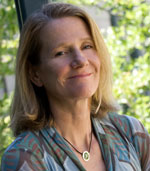 Previous research has found that analysts who rounded tended to work for small brokerage firms, to have relatively poor prior records of accuracy, to update their forecasts only infrequently, to have long forecast horizons, and to follow an above-average number of firms from multiple industries. Dechow’s research confirms these findings and corroborates the counterintuitive earlier discovery that experienced analysts tend to round more often than less seasoned colleagues, perhaps “because they are compensated less for accuracy as their tenure with the firm increases.”
Previous research has found that analysts who rounded tended to work for small brokerage firms, to have relatively poor prior records of accuracy, to update their forecasts only infrequently, to have long forecast horizons, and to follow an above-average number of firms from multiple industries. Dechow’s research confirms these findings and corroborates the counterintuitive earlier discovery that experienced analysts tend to round more often than less seasoned colleagues, perhaps “because they are compensated less for accuracy as their tenure with the firm increases.”
“Analyst incentives impact the likelihood of rounding,” Dechow explains in her article. “.Analysts can choose to be less informed about a particular stock and this choice affects how certain they feel about their forecasts, and, as a consequence, their decision to round…Analysts have limited time and so will rationally focus their forecasting efforts on firms for which the benefits of doing so are the highest.”
And what firms yield the most benefits? The study identifies these:
Firms with relatively small earnings per-share
About 34 percent of forecasts are rounded when annual earnings per share (EPS) is $1 or less, in contrast to 49 percent when it is from $1 to $10 and 60 percent when it is from $10 to $100. According to the authors, “As the level of EPS increases (1) the economic importance of the penny digit declines and so is less relevant to investors, and (2) the precision of the analyst’s information is not as likely to hold to the penny.”
Firms with high stock-trading volume
As the authors explain, a high-volume stock “offers greater opportunities for trades to pass through the brokerage division.” Analysts who provide more informative research are likely to generate more trading business, and this can benefit the analyst…In contrast, low trading volume offers fewer brokerage fee opportunities.”
Growth companies
Although assessing the prospects of growth firms “requires the analyst to exert effort and incur higher information-gathering costs to determine potential future opportunities…investors are also more interested in growth companies because of the greater potential gains, and this creates an increased demand for analyst guidance…Low-growth firms are likely to be less lucrative for the employers of analysts, and so we expect less forecasting effort.”
Companies that offer investment-banking business opportunities
Regulators have assumed that the potential to procure investment-banking business for their employers leads analysts to inflate the prospects of a stock. In addition, the study finds that it inspires the extra effort required of precise forecasts. In the words of the study, “Firms that are raising financing frequently select the investment bank that has a favorable analyst following the firm to underwrite the deal. Understanding this relation, an analyst who is covering a firm that is likely to need financing is likely to exert more effort in forecasting [and will be] less likely to round forecasts.”
Small companies or those with few business segments
The tendency to round increases with company size and complexity. In the words of the study, “larger firms are more complex than small firms, making them more difficult to analyze and value. In addition, if an analyst does provide an informative report, then this information is likely to be quickly dispelled among market participants and not necessarily captured by the analysts’ brokerage division.” As for number of segments, “companies with complicated business models require more effort to understand and therefore impose more costs on analysts…Controlling for firm size, firms with more business segments will have more rounded forecasts.”
What practical lessons can investors derive from the study? “Generally to be a little wary of rounded analyst forecasts,” Dechow says, “particularly for small companies or high-growth firms with heavily traded stocks (especially if they’re likely to want to raise money soon) or simply companies with low earnings per share. Those are all characteristics that should motivate precise forecasts. If they don’t, it could very well be a tip-off to hurried or cursory analysis.”
In an era when a stock can take a beating if earnings fall a penny short of analysts’ predictions, what factors influence whether forecasters seek precision to the penny or round off — and how should their choice affect investors? Accounting Professor Patricia Dechow found that rounded forecasts are not only significantly more inaccurate than those that strive for penny-precision but also significantly more upwardly biased. The sharpest differences in both respects occur in companies with annual earnings per share of less than $10.
Financial Times
Profs. Konchitchki and Patatoukas receive prestigious accounting literature award
Associate professors Yaniv Konchitchki and Panos Patatoukas have won the 2019 Notable Contributions to Accounting Literature Award from the the American Accounting Association.
The award was granted for two co-written papers: “Accounting Earnings and Gross Domestic Product,” featured in the Journal of Accounting and Economics, and “Taking the Pulse of the Real Economy Using Financial Statement Analysis: Implications for Macro Forecasting and Stock Valuation,” featured in The Accounting Review. Both were published in 2014.
The AAA award is given annually to work published within five years that has been evaluated for its uniqueness and potential magnitude of contribution to accounting education, practice and/or future accounting research; breadth of potential interest; originality and innovation, clarity and organization of exposition; and soundness and appropriateness of methodology.
The award, which is sponsored by the American Institute of Certified Public Accountants (AICPA), will be presented at the AAA Annual Meeting in San Francisco on August 14.

Konchitchki is a tenured associate professor Haas Accounting Group. His expertise is in the interdisciplinary links between financial reporting and analysis, capital markets, and macroeconomics. His work focuses on the modeling and resolution of real-world problems aimed at enhancing decision making, dealing with topics such as inflation, economic fluctuations/growth, monetary policy, real estate, inequality, and national accounting. He is a founder of the new research field of Macro-Accounting. Konchitchki has been recognized for his research and teaching as a Bakar Faculty Fellow, a Hellman Fellow, and a Schwabacher Fellow for distinguished research excellence; two Cheit Awards for Distinguished Teaching Excellence; Poets & Quants’ “World’s Top 40 Under 40”; and the American Accounting Association’s Financial Accounting and Reporting Section Best Paper Award.

Patatoukas is also a tenured associate professor in the Haas Accounting Group, and the L.H. Penney Chair in Accounting. His work focuses on interdisciplinary capital markets research and informs “micro-to-macro” and “macro-to-micro” questions bridging the gap between academics and practitioners. He was honored with the 2018 Distinguished Teaching Award, which is the highest teaching award bestowed by the University of California, Berkeley; the 2017 AAA/AICPA Notable Contributions to Accounting Literature Award; and the 2011 American Accounting Association Competitive Manuscript Award. He was also selected as a “Top-10 Business School Professor Under 40” by Fortune. He is the founding faculty director of the Berkeley executive education program on Financial Data Analysis.
How hedge funds use satellite images to beat Wall Street—and Main Street
Berkeley Haas research finds there may be a dark side to the rise of “alternative data” in capital markets

While Assoc. Prof. Panos Patatoukas was discussing Walmart in his Financial Information Analysis course last year, a student brought up the story of how company founder Sam Walton used to count cars in store parking lots to gauge how sales were going.
Patatoukas knew that sophisticated investors had begun doing exactly that on a large-scale basis by analyzing satellite images of retailers’ parking lots, and he began to wonder just how much of an edge it was giving them. So he called up the company that pioneered satellite-image car counting and pitched the CEO on the idea of letting an academic analyze the data. With the help of funding from the Fisher Center for Business Analytics, he landed 4.8 million images of parking lots at 67,000 individual stores across the U.S. owned by 44 major retailers, including Walmart.

The resulting analysis by Patatoukas and Assoc. Prof. Zsolt Katona—the first to quantify in detail the advantages of trading based on satellite imagery of parking lot traffic—found that the strategy can indeed deliver a significant boost for investors savvy enough to exploit it. Traders can accurately anticipate earnings news based on parking lot volume and earn significantly more than a typical benchmark return.
“The informational advantage yields 4% to 5% in the three days around quarterly earnings announcements, which is a significant return over such short window,” Patatoukas says. “If you annualize it, the number is staggering.”
The researchers also found that although this type of satellite data has been commercially available since 2011, the information hasn’t spread beyond a select few large investors, mostly hedge funds. That’s led to a consistently profitable strategy for hedge funds at the expense of individual investors, Patatoukas says: In particular, investors with access to satellite imagery data can get ahead of the rest of the market and target retailers with bad news for the quarter. This investment edge allows them to bet against those retailers by short selling their stock, even as individual investors are still buying.
“What we found is that it’s a gain for large sophisticated investors who can afford the substantial costs of acquiring and processing big alternative data at the expense of Main Street investors,” Patatoukas said. “If it was just a transfer of wealth between hedge funds, that would be a different story, but it’s small individual investors who tend to be on the other side of the trade.”
His working paper—co-authored by Marcus Painter at the University of Kentucky and Berkeley Haas doctoral student Jieyin Zeng—raises questions about individual investor protections in an age of new “alternative data” sources. Even as technology has made trading more accessible to the masses, the rise of big data is creating so-called alternative data that only those with superior resources are tapping into.
The “dark side” of big data
Skilled investors have always competed for an information edge that allows them to outperform the market by even fractions of a percentage point—that’s how Wall Street operates. Until recently, however, those traders had access to the same reports, earnings calls, SEC filings, and other public sources of information as everyone else. Trading on material non-public information, after all, is against the law, and the SEC makes detection and prosecution of insider trading one of its top enforcement priorities.
But technology is increasingly blurring the boundaries between public and private information, creating data opportunities that are legal, but are expensive and often require special expertise to access.
“Technology was supposed to level the playing field, but what I see is the fence separating sophisticated and unsophisticated investors growing higher,” says Patatoukas, who is passionate about teaching his students to analyze public sources of financial information and finds the trend troubling. “That’s the dark side of big data. Our evidence suggests that unequal access to alternative data leaves individual investors outside the information loop.”
How to formulate a trading strategy from outer space
RS Metrics pioneered the analysis of satellite images of parking lots in 2011, with hedge funds as their primary customers. Other companies such as Orbital Insight have followed suit, obtaining images from satellite companies and processing them with both software and human analysts. Not only is the data expensive, but it takes substantial skill to analyze and combine with other information sources to yield results, Patatoukas says. “You have to have the right people, and those people tend to be expensive.”
Patatoukas’ paper lays out exactly how investors can formulate a trading strategy from outer space. Using images from RS metrics from 2011 to 2017 covering 44 major U.S. retailers, including Walmart, Target, Costco, and Whole Foods, the researchers confirmed that year-over-year changes in the number of cars in individual stores’ parking lots is a reliable predictor of quarterly sales—a widely used metric for retailers’ performance. The researchers later added in more images from competing firm Orbital Insight, which covers the same companies, and found that combining the two datasets allowed for even more accurate predictions, and an even more profitable strategy.
In fact, parking lot volume is such a reliable indicator of retail sales that it can be used to identify errors in analysts’ forecasts in the three-week period after stores’ quarterly earnings are in, but before they’re announced to the public. Using data from Markit, a service that tracks daily institutional lending activity, they found a boost in stock lending in the five days before earnings announcements. That’s an indication of “informed short selling activity,” targeting retailers with bad news for the quarter (the strategy works with long and short-sale positions, but the researchers found it is most profitable for short sales).
Meanwhile, drilling into data on trading by individual investors during the same period, they found that individuals are net buyers of the same retailers that the hedge funds are betting against. Main Street investors can’t piggyback on what the hedge funds are doing since the short-selling market is opaque: The general investment community can only see short-interest data twice per month, and only with a significant delay.
In terms of market reaction to earnings announcements, they found no difference between retailers covered by the satellite image companies and those that are not. Clearly, the parking lot intelligence is not increasing price discovery for the market overall, Patatoukas says.
“Over the last seven years it’s been a pretty profitable strategy for hedge funds, and the value of the parking lot signals hasn’t yet been competed away. Part of that has to do with the fact that access to satellite imagery data has been so exclusive,” he says. “Once uncertainty about the signals has been removed and it’s known that there’s value to be extracted, more investors will start using it and the advantage will be competed away.”
In that regard, Patatoukas says, the dissemination of the working paper itself will impact the market for satellite parking lot data in the short term, since it provides the first independent analysis showing whether—and how—trading from outer space works.
Regulatory interest
In the aftermath of the financial crisis, there has been increased regulatory interest in the role of informed trading and disclosure requirements to protect the fairness and integrity of capital markets. With this in mind, Patatoukas hopes that the paper will get the attention of the regulators. “In a market setting where the line separating public from material non-public information is getting blurrier, the question that regulators need to answer is: What is their role in terms of leveling the playing field for individual investors?”
While the value of the parking lot data will dissipate as technology improves and it becomes more accessible, investors will no doubt find new data sources that will yield insights once only available to company insiders. For example, investors may already be harvesting geolocation data from inside consumers’ pockets as they move around stores with their smartphones, Patatoukas says.
“This is just the tip of the iceberg,” Patatoukas says. “While so far the focus has been mostly on the bright side of big and alternative data, there might be a less auspicious side to the rise of such data in capital markets.”
Prof. Xiao-Jun Zhang’s intentional teaching
In honor of Asian Pacific American Heritage Month, we’re featuring profiles and interviews with members of our Haas community.
Prof. Xiao-Jun Zhang moved to the U.S. for love, and stayed because he built a family and a career here.

Since he joined the Haas Accounting Group in 1998, Zhang has become a much-loved professor, opening the minds of generations of students to accounting—even those who start out thinking it’s boring. He twice won the Cheit Award for Excellence in Teaching in the Evening & Weekend MBA program, and last year he made Poets & Quants’ list of the favorite professors of executive MBA students.
Zhang shared how his his life has been a “fate-guided series of decisions,” and how his cultural perspective influences the way he runs his classes in a very intentional way.
Where were you born and where did you grow up?
I was born and raised in Beijing, China. I went to primary school, high school, and college all in Beijing.
When did you move to the U.S., and why?
I moved to the U.S. in 1992 and the reason was simple: My wife—who was then my girlfriend—transferred to Mount Holyoke College in Massachusetts, so I decided to follow her to the U.S.
Did you think you’d stay here?
I was young then and didn’t think too much about my long-term plans, including whether to stay in the U.S. or not after graduation. The end result of staying here was more of a fate-guided series of decisions, driven by family more than a deliberate career path.
How did you come to Berkeley?
At the time, I was choosing between several schools—including Berkeley, Chicago, Yale, and Duke. What made Berkeley stand out was my research area of financial statement analysis. My advisor, James Ohlson, had worked here, and my frequent co-author, Steve Penman, was here at that time. From the research collaboration perspective, Berkeley was a natural fit. Also, my wife really wanted to live in the Bay Area.
Was there anything about Berkeley’s culture that attracted you?
If you look around the country, I would characterize Berkeley as of one of the most open-minded places. There’s a strong emphasis on equality, on judging people based on what he or she can contribute, rather than more superficial aspects. For people of Asian origin, feeling that sense of fairness is important. I would choose to work among colleagues who share that same sense of equality and fairness.
Having grown up in China, do you feel like you have a different perspective—as an academic and a teacher—than your American-born colleagues?
I would say so. The way you grew up shapes you consciously and unconsciously in so many ways. I’ll give you an example. In the classroom, I find it easier to understand certain student behaviors, especially with students from Asian countries. In the classroom in China, all we were supposed to do was take notes and memorize what we were told. You’re not supposed to ask questions. I suppose there’s similar cultures in Japan, Korea, and other Asian countries. When you teach graduate classes at Berkeley, you notice students from those cultures tend to be more reserved. I tend to be understanding, and when I design my class, I try to create a very relaxing environment without a lot of pressure to participate. It’s really rewarding when you see these students gradually warm up, and at the end of the semester they are as active as the others.
So do you put less emphasis on participation in their grades?
I put as much emphasis on participation, but I redefine it. I don’t count the number of questions they ask. To me, whether a student has been following the class is the most important thing. I tell the students that, after so many years of teaching, I know just by looking at your eyes whether you’re following the class. Once you take that pressure off, students start to participate in a natural way, rather than trying to think of a question just to ask a question.
That’s so interesting. There’s a lot of discussion around Haas and at business schools about inclusion. People have noticed that men often dominate classroom conversations and are working on changing that culture. Do you find that women tend to speak up more in your classes because of the atmosphere you create?
I don’t pay attention to whether it’s a man versus a woman, but I do tell students, “You may notice sometimes you raise your hand but you don’t get called on. Don’t take it personally, but I want to give priority to whoever hasn’t spoken so far.” Most of the students have no problem with that. Once you tell them, “Your role is just keep raising your hand,” they are likely to continue doing it but they can relax.
You’re a well-loved teacher—you’ve won the Cheit Award twice, and last year you were on Poets & Quants list of favorite exec MBA students. What do you like about teaching accounting?
I like helping them realize that accounting is not just a bunch of rules. Accounting is a way of thinking, in the sense that it’s looking at a business from the financial perspective. You can have all these fancy business plans, but in the end, you’re going to be measured by how the financial aspect works out. When students realize they need to learn this to operate in real life they get excited. Most rewarding is when you see the light bulb go on, and they see that accounting is not boring and it can actually be exciting. Then you just leave the rest to them. They will learn it all by themselves. At the end of the day, they give you credit for what they’ve learned, and they start liking you.
So from that perspective, you don’t have to teach them much beyond the first week?
In some sense yes. Once you help them realize what accounting really is, they will do all the work and teach themselves.
Can you share an example of your recent research?
In finance and accounting there is the book-to-market ratio phenomenon. Basically, people find that the book value (or accounting value) divided by the market capitalization somehow correlates with future stock returns. People got very excited about this idea because it seems they could make money off it. From the academic perspective, the question is why? I think part of the reason has to do with accounting, in the sense that the book value tends to reflect a stock’s downside risk due to the conservatism-bias in accounting. As a result, the book-to-market ratio reflects a stock’s upside potential relative to its downside risk. Another ingredient to this phenomenon is investors’ preference for “positive skewness” in stock returns: In other words, when you make an investment and receive huge return from it, you get a disproportionately high degree of satisfaction. Now you can brag about it at dinner parties, for instance. Maybe the other nine of your ten stocks don’t do well, but that doesn’t seem matter as much. Putting these two ingredients together, we start to see why investors like stocks with a low probability of huge upside potential, which leads them to prefer the so-called growth stocks.
That sounds like almost like a behavioral finance perspective. Is it rational to put faith in a low probability of a high return over a more certain, smaller return?
I would say yes, because these investors get significant happiness from this one big return. The same reasoning underlies people’s preference for gambling. Going after things that make you happy is rational. Trying to understand human behavior and what really gives humans happiness—or what they call in economics “utility”—is quite complicated and quite fascinating to dive into.
Do ever think you’d move back to China?
I don’t see any reason why I’d want to go somewhere else. I couldn’t ask for a better academic environment than Berkeley, in terms of freedom of thinking. Also my family loves living here. Your home is where your family is. I go to Beijing from time to time, but the Beijing of today is completely different from the city I grew up in. The hometown I grew up in will just be in my memory forever.
Leo Helzel, MBA 68, longtime Haas supporter and first entrepreneurship teacher, passes away

Leo Helzel, MBA 68, LLM 70, an honored faculty member who guided the school’s first forays into entrepreneurship and was a dedicated and generous supporter of Haas for decades, passed away Thursday, March 21, in his home, surrounded by family. He was 101.
Helzel’s history at Haas includes a series of firsts. He taught the business school’s first entrepreneurship class—one of the first such courses offered at a U.S. business school. He was also the first chair of the Haas School Board, which advises the dean, and the first Haas instructor to be honored with an “adjunct professor emeritus” title upon retirement in recognition of his nearly forty years of service.
Helzel was instrumental in establishing the school’s entrepreneurship program. In addition to teaching, he provided the funding to endow the Leo B. and Florence Helzel Chair in Entrepreneurship and Innovation in 1986. He worked closely with then-Dean Richard Holton to create the business school’s Lester Center for Entrepreneurship and Innovation, which opened in 1991.
Helzel summarized his entrepreneurial verve and lifelong learnings—alongside wisdom from the CEOs of the Gap, Bank of America, and Williams-Sonoma—in his 1995 book, A Goal is a Dream with a Deadline: Extraordinary Wisdom for Entrepreneurs, Managers, and Other Smart People, and donated the proceeds to Haas.
“Leo was one of those people who changed the game whenever he was around, raising standards and pushing people to reach for more together,” said Professor and former Dean Rich Lyons, who worked closely with Helzel on the board and beyond. “He taught me a lot. It’s hard to imagine a stronger exemplar of our school’s defining leadership principles.”

Helzel was born in New York City on November 1, 1917, to Philip and Hannah Helzel; he had two older siblings, Sylvia and Max. His parents had immigrated from Podhajce, a shtetl that was part of the Austro-Hungarian Empire, before World War I. He graduated from Townsend Harris, a tuition-free honors school for the City College of New York. He then worked full-time at his uncle’s accounting firm, Gerber & Landau, while attending ROTC and night classes at City College, graduating in 1938.
Called up to serve during World War II, Helzel flew as a navigator on Navy planes and served as a navigation flight instructor. His home base was the Alameda Naval Air Station, and after the war he stayed on in Oakland, launching several successful careers—as an accountant, a lawyer, and an entrepreneur.
In 1946, Helzel founded Leo B. Helzel & Company, now called the RINA Accountancy Corp., in Oakland. Aspiring to become a lawyer, Leo took night classes at Golden Gate University while also teaching tax and accounting there. In 1957, he decided he wanted to concentrate on law full time and left the firm as a partner, but remained as a client. He eventually took a risk on new technology for drilling oil wells and was successful in that arena as well.
Helzel began sharing the knowledge acquired during his multiple careers when he began teaching international business at Berkeley’s business school in 1967. While teaching, he decided to get an MBA, and upon completing the program at age 51 joked that he was “probably the oldest MBA in the books.” He went on to earn his Master of Laws (LLM) from Berkeley Law in 1970.
In 1970, Richard Holton, dean at the time and a friend of Helzel’s, came up with the idea of creating an entrepreneurship course and hired him to teach it. Helzel initially presented a case about a fictitious startup, Miracle Goggles. He later invited entrepreneurs whom he knew to share their stories with his class. Interest in the companies emerging in Silicon Valley was so intense that the course soon had to be moved to an auditorium. The course may have been the first to provide students with direct contact with successful entrepreneurs, according to Business at Berkeley by Sandra Epstein.
“Leo was a thought leader decades ahead of others in bringing real business practices and live case studies into the classroom from the time he began teaching here in 1967,” said his former student Jerry Weintraub, BS 80, MBA 88, and president of Weintraub Capital. “As a depression-era child who came from humble beginnings, Leo took immense pride in Haas—the opportunity this public institution gives to students and the impact education can have on improving the lives of others. Leo has left a legacy as an incredible agent of change in education, philanthropy, and the community through his mentorship and friendship to those of us lucky enough to have known him as a teacher.”

Helzel also taught business law and commercial law at Haas, creating the course called Top Down Law with Adj. Prof. Noel Nellis, JD 66. The course taught business from the perspective of an entrepreneur who encounters legal problems.
“Leo was indeed a friend, mentor, and educational innovator. His leadership role in creating our entrepreneurship program is well known. More subtle perhaps, and one of his biggest innovations at Haas, was recruiting accomplished professionals to join our professional faculty,” said Jerome Engel, founding executive director emeritus of the Lester Center for Entrepreneurship and Helzel’s long-time faculty colleague. “We at Haas will benefit from his foresight, leadership, and generosity for generations. We will miss him. May his memory be a blessing to all of us.”
Helzel gave generously to the Haas School’s original campus that opened in 1995 and to its new building. In return, the Helzel Boardroom and a “Helzel Family” breakout room are named in his honor. He was also a Trustee for Golden Gate University and for the California College of the Arts, served on the board of BerkeleyLaw, and was active in several Bay Area nonprofit organizations.
He is survived by his loving family—his wife of 72 years, Florence; his two children and their spouses, Larry Helzel (Rebekah) and Deborah Kirshman (David); grandchildren Rachel Concannon (Jason) and Daniel Kirshman, MBA 2011 (Jennifer); great-grandchildren Riley and Jacob Concannon and Sienna and Skylar Kirshman; great-nephew Zachary Pine; and several other family members with whom he maintained close relationships.
A private family service has been held.
Contributions in Helzel’s memory may be made to the Magnes Collection of Jewish Art & Life, UC Berkeley, 2121 Allston Way, Berkeley, CA 94720-6300; givetocal.berkeley.edu/magnes.
Haas List

Centers and Institutes
1. Equity-Fluent Leadership
Educating “equity fluent” leaders–those who are able to engage in difficult and uncomfortable conversations and who are empowered to design creative solutions–is a goal of Haas’ Center for Equity, Gender, and Leadership (EGAL), which launched last year thanks to donor support, including a founding gift from the Gap Foundation. In August, EGAL received a four-year, $1 million gift from customer service software maker Zendesk, bringing total funding to about $3 million.Recently, French gaming company Ubisoft announced a partnership with EGAL to support MBA students researching gender equality and diversity in the video game industry. EGAL supports faculty research and student fellowships and hosts pitch and case competitions, panels, and the AmpEquity Speaker Series, which recently featured famed women’s rights attorney Gloria Allred. View the video: haas.org/allred.
Green Initiatives
2. Zeroing In

After conducting a zero-waste audit of Chou Hall this fall–which involved sorting through compostable and recyclable bins to determine whether trash is being disposed of correctly–the Chou Hall Zero Waste Initiative determined that Haas’ new building is on track to become the first TRUE Zero-Waste-certified academic building in the U.S. and the first certified UC building by year’s end. Some education is still needed before the U.S. Green Building Council conducts its own audit. Energy-bar wrappers and boba tea cups, which often aren’t recyclable or compostable, appear a lot in the bins.
Lifelong Learning
3. Tiffany Talks Economy

Hundreds of alumni tuned in to Facebook Live to watch Haas Senior Lecturer Paul Tiffany, PhD 83, present his talk, “The Global Economy in the Era of Trump”. The session explored recent upheavals in the world economy that have led to current challenges and considered potential outcomes for the years ahead, including the implications for both U.S. firms and citizens. Watch for yourself: haas.org/tiffany-lecture.
Rankings
4. Hub for Blockchain

Coindesk, a news site specializing in bitcoin and digital currencies, ranked UC Berkeley No. 2 in its list of Top 10 Blockchain Universities, behind Stanford. The university was noted for its interdisciplinary approach to staying at the forefront of emerging technologies as well as for having one of the nation’s most vibrant on-campus communities, with the student-led Blockchain at Berkeley group and blockchain clubs at Haas and Berkeley Law.
Publications
5. News Flashes

Subscribe to our weekly Haas in the Headlines email to learn where our faculty, students, and alumni are making news:haas.org/headlines.
Rankings
6. Moving Up
U.S. News& World Report boosted the Haas UndergraduateProgram to No. 2 in this year’s college ranking, tied with MIT Sloan. Haas was No. 3 last year.
Students
7. Walk of Life

That Haas junior Robert Paylor is even alive after a paralyzing rugby accident 16 months ago is amazing. That he’s starting to walk again? Miraculous. In spring 2017, Paylor suffered a spinal cord injury at the Varsity Cup championship match between Cal and ArkansasState. Doctors said he’d likely never walk again. But Paylor disagrees. He works out twice daily between classes and meets regularly with Assoc. Head Coach of Cal Rugby Tom Billups, who helps Paylor power through 50-yard laps using braces and a walker. Every step requires his full focus. Paylor’s current personal record is 600 yards, and he showed off his progress this fall at the Cal-Oregon football game. Paylor walked across the field while fans for both teams stood and cheered.
Gender Balance
8. Leading Ladies

Haas Leaders. Top: Dean-designate Ann Harrison; Chief Strategy and Operating Officer Courtney Chandler, MBA 96; CFO Delphine Sherman, MBA 06. Bottom: Co-Chairs of the Faculty Catherine Wolfram and Candace Yano; Haas Interim Dean Laura Tyson
CNN Business reported earlier this year about GeneralMotors joining an “exclusive club” of Fortune 500 companies with females in both the CEO (Mary Barra) and CFO (Dhivya Suryadevara) roles. Only Hershey can also make this claim. The trend is not so rare at Haas and Berkeley, however. Haas’ Interim Dean, Laura Tyson; Dean-designate, Ann Harrison; CFO, Delphine Sherman, MBA 06; Chief Strategy and Operating Officer, Courtney Chandler, MBA 96; and Co-Chairs of the Faculty, CandaceYano and Catherine Wolfram, are all female, as are UC Berkeley’s Chancellor, Carol Christ, and CFO, RosemarieRae. Not to mention UC President Janet Napolitano.Among the top 15 business schools nationwide, none have women in both roles. One, Kellogg, has a female interim dean (Haas alum Kathleen Hagerty, MBA 80), and a handful have women in a CFO or similar role.
Faculty
9. One to Watch
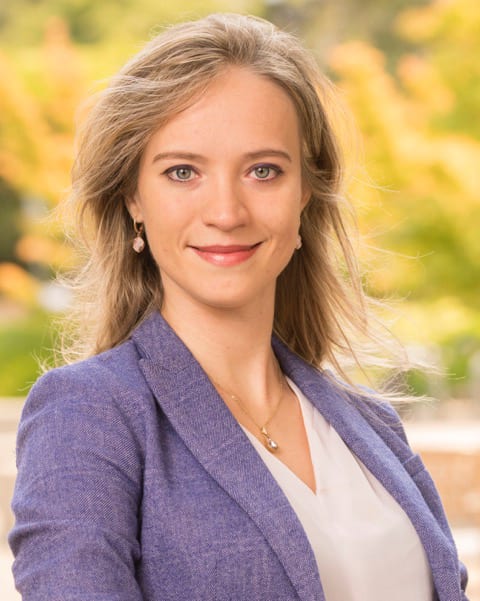
New Asst. Prof. Anastassia Fedyk, a rising star in finance and behavioral economics, was named to a list of 2018 “MBA Professors to Look Out For,” published by BusinessBecause.com. Fedyk is currently researching the influence of financial news on markets, bias and procrastination, and how employees’ skills relate to companies’ performance.She studied math at Princeton and spent two years doing research at Goldman Sachs before earning her PhD in business economics at Harvard. Coming to Haas is a homecoming of sorts for Fedyk. She spent her high school years in Berkeley while her mother, Tatiana Fedyk, earned her PhD in accounting at Haas in 2007.
Assoc. Prof. Patatoukas wins UC Berkeley’s most prestigious teaching award
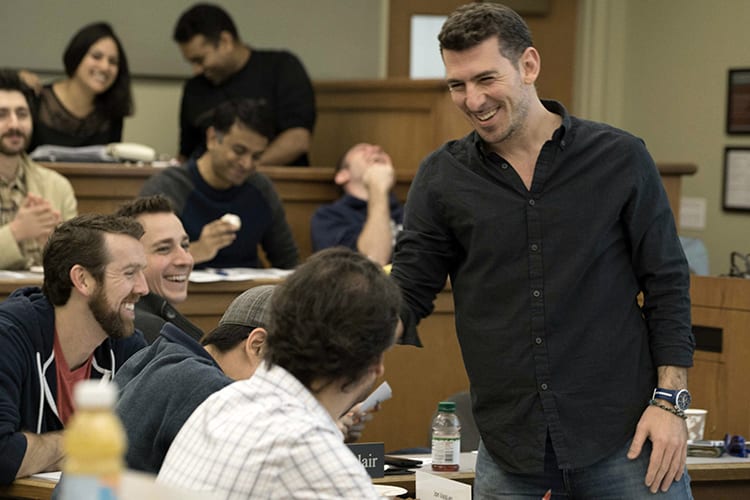
Assoc. Prof. Panos Patatoukas has helped students find unexpected career paths in finance, launch companies, and open their eyes to the “intrigue, mischief, and opportunity boiling just below the surface of financial statements.”
For Patatoukas, it’s all in the service a larger purpose: democratizing access to financial information in the interest of a more equal society.
His passion, dedication, and instructional inventiveness have now earned Patatoukas UC Berkeley’s highest teaching honor. He is one of four professors across campus to receive a 2018 Distinguished Teaching Award, to be bestowed at a ceremony April 18.
 “This is a very significant event for me, and I feel very honored,” says Patatoukas, who joined the Haas Accounting Group eight years ago just after earning his PhD from Yale University. “My mom did not get to come to any of my graduations, but I’m bringing her over from Greece for this one.”
“This is a very significant event for me, and I feel very honored,” says Patatoukas, who joined the Haas Accounting Group eight years ago just after earning his PhD from Yale University. “My mom did not get to come to any of my graduations, but I’m bringing her over from Greece for this one.”
The award is given annually to recognize sustained excellence in teaching that “incites intellectual curiosity in students, engages them thoroughly in the enterprise of learning, and has a lifelong impact.”
Patatoukas teaches interdisciplinary capital markets courses to students in the Berkeley Haas PhD and Evening & Weekend MBA programs, including the elective Financial Information Analysis, which has become one of the most in-demand courses in the program since he took it over. Far from dry number crunching, the class wins high praise from students who come in with a wide range of financial literacy—from investment bankers to computer science or humanities majors.
“Panos has a particular genius for teaching financial information analysis to those of us unaccustomed to finance,” wrote Walker Frost, EWMBA 16, an undergraduate philosophy major who now manages finances for a 50-person company. “Panos is so successful because his goal is not just to teach finance—it is to use financial analysis tools to teach us about things we already intuit but can’t yet explain.”
Talent for teaching all levels
Patatoukas’ work spans all academic levels. He serves as PhD field advisor for the accounting group, overseeing student recruiting, curriculum, and comprehensive exams while also teaching seminars and participating in dissertation committees. He also serves as faculty director of Berkeley Executive Education’s Financial Analysis for Leaders program, which he completely overhauled; he mentors undergraduate Regent Fellows; and he has introduced high school students to the idea of saving and compounding through the Berkeley Business Academy for Youth.
“The driving force of my teaching is to mitigate the problem of access inequality to financial information, to promote individual investor protection, and improve the allocation of capital in society,” he wrote in his teaching reflection for the award. “My goal is to democratize the power of financial analysis, and to bring this power to our students across various programs at UC Berkeley.”
A native of Greece, Patatoukas was valedictorian at Athens University of Business and Economics, where he earned his bachelor’s in accounting and finance. He went on to earn a master’s at the London School of Economics before moving to the US to attend Yale. His research focuses on corporate valuation and financial statement analysis; the properties of financial accounting data and reporting practices; cross-industry economic links and value creation along the supply chain; and forecasting, “nowcasting,” and measuring economic activity using financial accounting data.
Making finance “a living, breathing landscape”
In his teaching, Patatoukas draws widely from accounting, finance, economics, and operations management, writing many of his own real-life, real-time cases and adeptly translating theory to practice. Teaching does not compete with his research, but rather his research informs his teaching and rewards him with new ideas—a few of which have grown into research papers, wrote Assoc. Dean Candi Yano and Sr. Asst. Dean Jay Stowsky in their nomination.
“I wish I had the opportunity to be a student at Berkeley, even though I do feel like a student of my students,” Patatoukas said. “I learn every day from them.”
One former MBA student wrote that with four years of experience investment banking, she had been initially skeptical that she would learn anything from an MBA course in financial information analysis. But from the very first day, she was hooked. She came away from the course with insights that have benefited her career but also impacted how she evaluates her personal financial decisions.
Students also praised Patatoukas for helping them develop in new careers. Patrick Rivers, EWMBA 16, said he took the course soon after switching tracks from 10 years as a research scientist to a dream job at a hedge fund, evaluating biotechnology investments. He said the course not only gave him a concrete way to evaluate investment opportunities and practical skills that made him “100% better” at his job, but he became genuinely excited about the world of finance.
“There was an entire world of intrigue, mischief, and opportunity boiling just below the surface of these financial statements, and I wanted to be as immersed as possible in that financial milieu. Panos made this a living, breathing landscape and not just a bunch of numbers on a page,” he wrote in his recommendation letter.
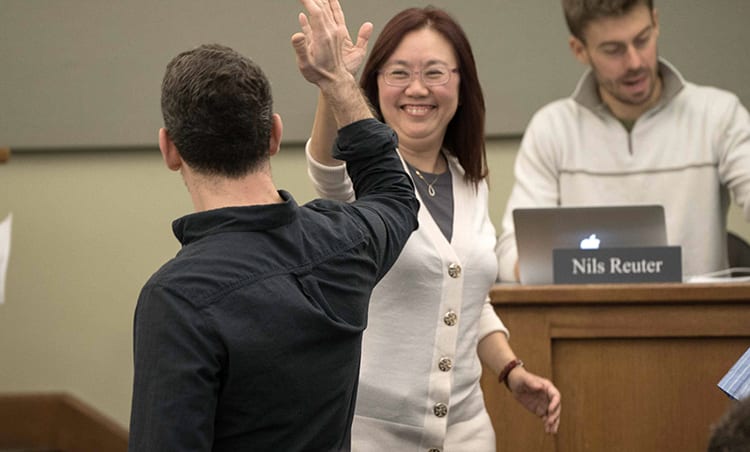
Approachable mentor
Last fall, Patatoukas also took on the mentoring of three undergraduate Regent Fellows, including freshman David Lu, who wrote that he had felt overwhelmed and uncertain after changing his life-long dream of becoming a doctor and deciding to pursue business. Patatoukas is “the most approachable, kindhearted, charismatic and welcoming professor I have ever met,” and has been patient in describing career paths in business and the fundamentals of investing as well as the broader social implications of his work, he said.
“His goal of democratizing the power of financial information analysis and giving power to all people truly embodies the defining principles of Berkeley Haas,” Lu wrote. “He has proven to me, through his actions, that it is possible to have such altruistic and benevolent goals in the business field.”
Prof. Sunil Dutta, the Joan & Egon von Kaschnitz Distinguished Professor of Accounting and International Business and former chair of the accounting group, attributes Patatoukas’ exceptional teaching skills to his passion for his students and for his research, his ability to translate academic material to non-specialists, and his constant focus on improvement. “He studies each student’s feedback after the course and makes all the necessary changes to the content and teaching material based on this feedback. He is not satisfied even if there is a single student who has difficulty in following the material.”
He also makes himself available to students, guiding MBA independent study projects and mentoring graduate student instructors, noted Mike Rielly, CEO of Berkeley Executive Education and former assistant dean for the Berkeley MBA for Executives program. Rielly also called out Patatoukas’ “commitment to developing independent thinkers.”
Highly lauded teacher
The award comes on top of several other recognitions for Patatoukas’ teaching and research. He is a three-time winner of Berkeley Haas’ highest teaching honor, the Earl F. Cheit Award; he also won the school’s Schwabacher Award for Distinction in Teaching and Research and was the recipient of the 2017 AAA/AICPA Notable Contributions to Accounting Literature Award. He was also selected by Poets & Quants among the “2015 Best 40 Under 40 Professors“; by the San Francisco Business Times as part of the “40 under 40 Class of 2017,” and as a “Top 10 Business School Professor Under 40 by Fortune.
Past Berkeley Haas faculty winners of the Distinguished Teaching Award include:
- Ulrike Malmendier (2015)
- Teck-Hua Ho (2010)
- Sara Beckman (2001)
- Rich Lyons (1998)
- David Modest (1992)
- Earl Cheit (1989)
- Frances Van Loo (1985);
- Andrew Shogan (1979)
- Richard Bagozzi (1978)
